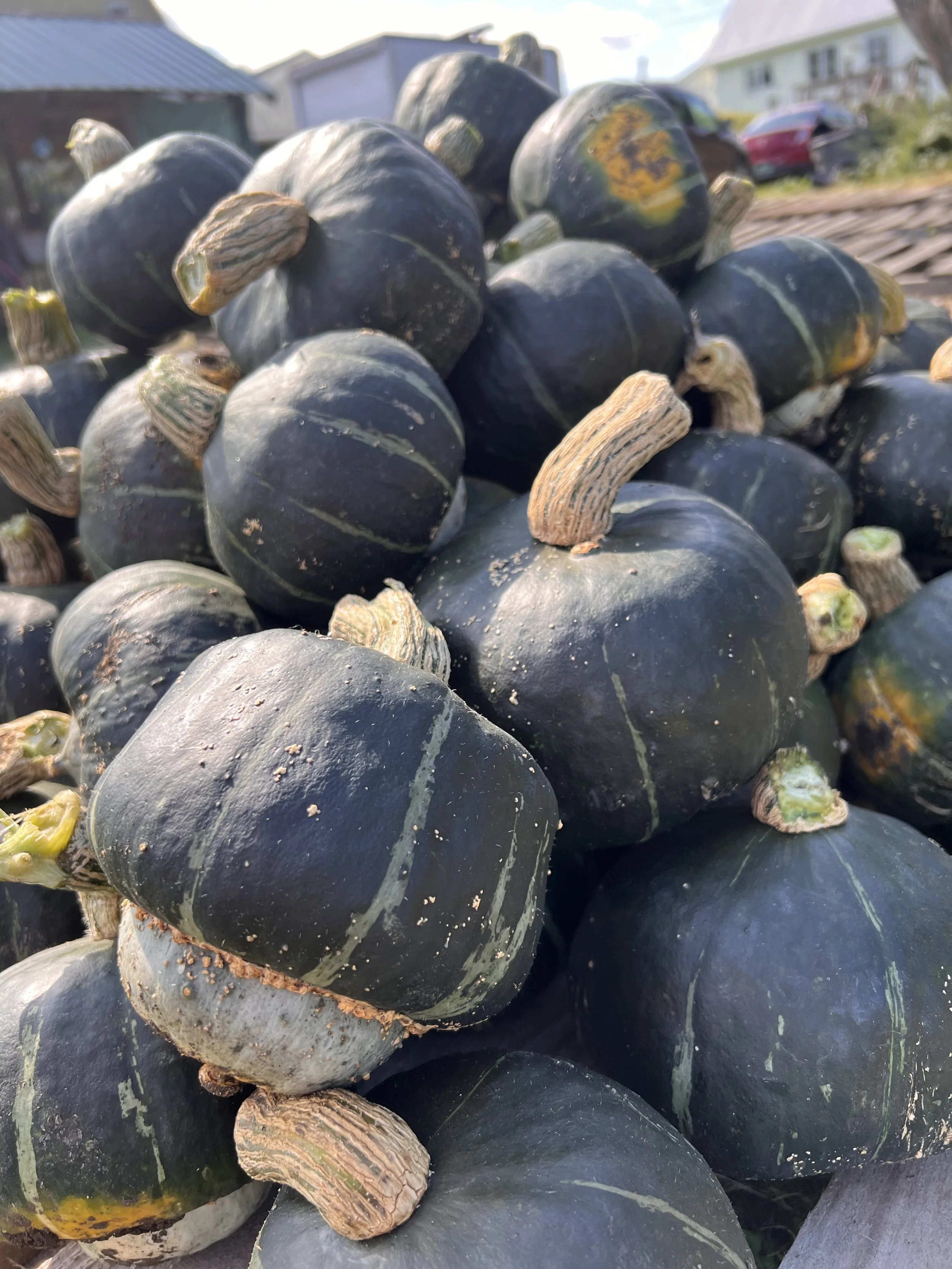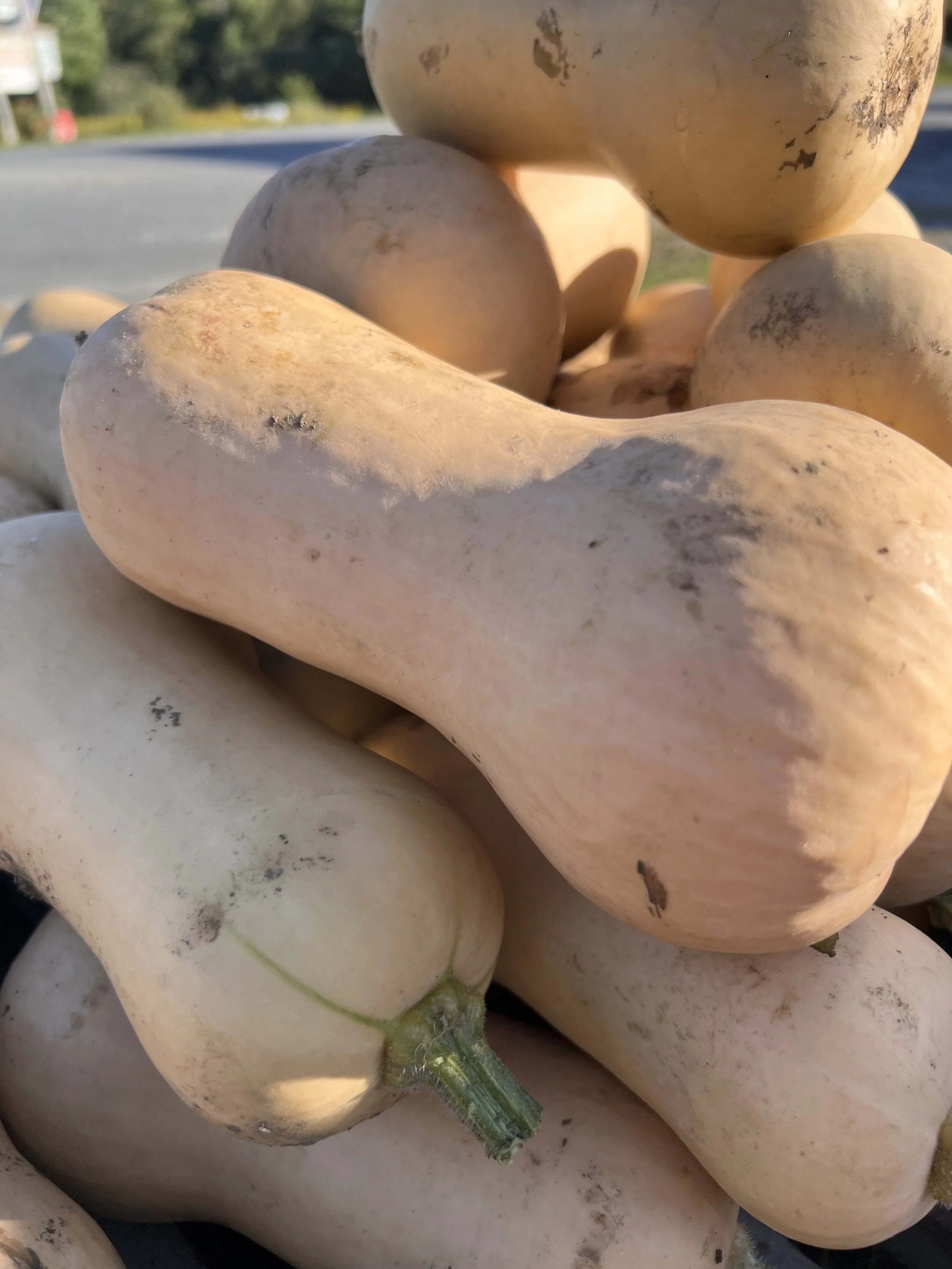Eating Through Winter Squash!
The joy of Winter Squash! I wait for it each season! Actually, my taste buds get all primed for winter squash all the way in Early May when the seeds get started in the greenhouse for transplant!
A Few interesting facts:
It takes approximately 100 days from seed to harvest to produce a winter squash. Each plant on average, can produce 3 winter squash. (Varies with variety)
Time of harvest is vital, as well as curing for long-term storage (we wait until the stem begins to get dried down a bit — but even then, waiting several weeks before eating always produces the best tasting squash)
Squash continue to ripen off the vine, so storing in a cool, dry location for winter eating is vital. Alternatively, squash freeze well!
This season, we have be purposefully eating through each variety, noting what we liked, didn’t like, how dry or moist they are, and generally just observation, which influences what we choose to grow for the following year.
So…. Here we go!
BUTTERCUP: In the Northeast Kingdom — This is a tried and true variety — familiar to many, and if you know about this variety, highly sought after. Green on the outside, with the classic “Button” on the bottom, along with beautiful orange flesh on the inside. Best baked in the oven, or what I have been doing lately — right into the Instant Pot! The oven yields a dryer texture, which is vitally important to some, compared to a bit more moisture from pressure cooking in the Instant Pot, which produces a more moist texture…. and it is so quick. (approx 20 min. once pressure is reached)
Buttercup is a “heirloom” variety, “Burgess” being the name you may be familiar with. (A tried and true variety) .
A newer form of Buttercup, which we find very productive, is a variety called “Bon Bon”. I am not sure in a taste test there would really be that much difference. We love this variety because it is highly productive in the field.
Buttercup!
BUTTERNUT: I have come to realize that this variety is quickly becoming the “go to” squash for many, because it is more widely available in other parts of the country. My daughter, living in Ohio, can only find this variety, as the tried and true “Buttercup” is not readily available.
Butternuts, are a great squash. Sweet, moist flesh, a bit on the yellow-tan side. This squash is “bell-shaped”, where you will find the seed cavity in the middle. They are delicious baked with a top drizzle of pure maple syrup! Although they are sweet and delicious on their own, Maple, and maybe some chopped walnuts are a great topping for a special meal - such as Thanksgiving Dinner!
Best after a good 2 months in storage (again, a cool, dry place will facilitate the best environment for storing)
Baking in the oven is the most preferred way to prepare — and the easiest of all. (Toss some baking potatoes in the oven along with your squash!)
Make it stand out
Butternut!
KABOCHA: I remember the year “Sunshine”, a very popular Kabocha variety was being trialed. I jumped on the bandwagon that very year and was able to trial some seeds! Wow!!!! We have grown this ever since. If you have visited our Farm Stand and purchased your winter squash needs here, you will easily recognize this variety because they are a bright “Sunshine Orange” as well as the flesh inside. There are not too many who after trying this variety are not as “hooked” on it as we are!
In my experience, they are not as long of a “Keeper” as Buttercup, but they will easily store through the Thanksgiving season, if in the proper environment.
Sunshines, flesh is smooth, tender, sweet, and such a beautiful orange. It really “pops” on your dinner plate. It does not need anything but some butter, salt and pepper. Again, best baked, as this variety can tend to be a bit more moist.
Another Kabocha variety; MAMBO! Now this is where it can get a bit tricky. Mambo looks very close to a green-skinned Buttercup (above), but the telltale difference is the lack of the big “button” on the bottom. Same color flesh as buttercup, and also a similar taste… (maybe not as sweet). They have exceptional storage capacity, which makes them shine if long-term storage is your goal.
ACORN: Well, acorn squash are easy to spot! They are tiny round balls of deliciousness! Usually single serve and just such a great addition to an evening meal when you serve a 1/2 in the shell, after baking in the oven. Easily eating, but just scooping out the flesh, topped with a bit of butter, salt, pepper, and maybe a drizzle of pure Maple Syrup. They are hard to cut in half, so you need a sharp knife! They store very well, and will often be the last squash to succumb to long-term storage.
HUBBARD: A beloved heirloom with a hard, bumpy, blue-green shell. A fall tradition at New England roadside stands. Medium-dry, medium-sweet yellow flesh. You can easily recognize these, because they are HUGE!!! There is a relative of the hubbard, called “Blue Ballet” — a smaller version, with fiberless flesh and texture. Both very long storage varieties, and a traditional “Thanksgiving” squash!
SPAGHETTI: This is a fun variety, with the shortest storage capacity. Cutting these in half, baking until just done, yields a perfectly spaghetti-type texture, which scraped out with a fork. Pairing this squash with your favorite homemade Pasta sauce — with or without meat can make a very nutritious, and more importantly, “low carb” spaghetti dinner for those who are carb-conscious. They are also delicious served with a bit of butter and parmesan cheese sprinkled on top.
Hoping this blog was helpful and informative! My advice to you! Come to the Farm Stand soon and get stocked up on squash! We didn’t even cover nutrition, but for your added education:
Winter squash provide a beautiful mix of:
Carotenoids: beta carotene (a precursor to vitamin A), lutein, zeaxanthin
Diabetes: Squash is a dense, filling food despite being fairly low in calories (45-90 calories per cup cooked, depending on type) with a low glycemic index. Squash also contains polysaccharides, a type of indigestible fiber that can prevent blood sugar from rising after eating.
Cancer: Certain compounds in squash like beta-carotene and lutein are classified as flavonoids that may help to protect human cells from the damaging effects of oxygen. Flavonoids have been researched extensively for their possible role in affecting or inhibiting cancer cell growth.
Heart health: Winter squash is rich in potassium (about 500 mg in 1 cup of cooked butternut or acorn squash)!
One last fun fact: Winter squash is technically classified as a fruit, but for culinary purposes is treated like a vegetable.
Ready to try some squash today?
See you at the Farm Stand!
Kathy


